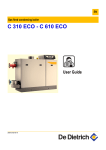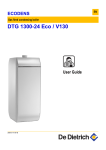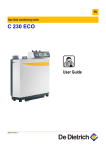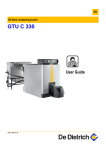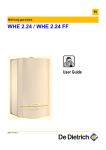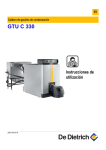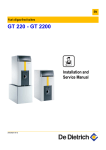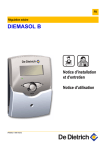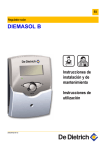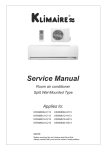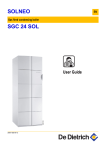Download DeDietrich CBI-II User guide
Transcript
EN Reverse combustion log-fired boiler CBI-II / CBB 15 E User Guide 300019729-001-C . Contents 1 Used symbols . . . . . . . . . . . . . . . . . . . . . . . . . . . . . . . . . . . . . . . . . . . . . . . . . . . . . . . . . . . . . . . . . . . . . . . . . . .3 2 Important recommendations . . . . . . . . . . . . . . . . . . . . . . . . . . . . . . . . . . . . . . . . . . . . . . . . . . . . . . . . . . . . . . .3 2.1 2.2 2.3 3 Description. . . . . . . . . . . . . . . . . . . . . . . . . . . . . . . . . . . . . . . . . . . . . . . . . . . . . . . . . . . . . . . . . . . . . . . . . . . . . .5 3.1 3.2 3.3 3.4 4 Installing the heating. . . . . . . . . . . . . . . . . . . . . . . . . . . . . . . . . . . . . . . . . . . . . . . . . . . . . . . . . . . . . . . . . . . . . . . . . . . . . . . . . . . . . .5 Safety . . . . . . . . . . . . . . . . . . . . . . . . . . . . . . . . . . . . . . . . . . . . . . . . . . . . . . . . . . . . . . . . . . . . . . . . . . . . . . . . . . . . . . . . . . . . . . . . .6 Boiler . . . . . . . . . . . . . . . . . . . . . . . . . . . . . . . . . . . . . . . . . . . . . . . . . . . . . . . . . . . . . . . . . . . . . . . . . . . . . . . . . . . . . . . . . . . . . . . . .7 Control panel . . . . . . . . . . . . . . . . . . . . . . . . . . . . . . . . . . . . . . . . . . . . . . . . . . . . . . . . . . . . . . . . . . . . . . . . . . . . . . . . . . . . . . . . . . .8 Commissioning . . . . . . . . . . . . . . . . . . . . . . . . . . . . . . . . . . . . . . . . . . . . . . . . . . . . . . . . . . . . . . . . . . . . . . . . . .9 4.1 4.2 4.3 4.4 5 Ventilating the boiler room . . . . . . . . . . . . . . . . . . . . . . . . . . . . . . . . . . . . . . . . . . . . . . . . . . . . . . . . . . . . . . . . . . . . . . . . . . . . . . . . .3 Maintenance . . . . . . . . . . . . . . . . . . . . . . . . . . . . . . . . . . . . . . . . . . . . . . . . . . . . . . . . . . . . . . . . . . . . . . . . . . . . . . . . . . . . . . . . . . . .4 Fuel. . . . . . . . . . . . . . . . . . . . . . . . . . . . . . . . . . . . . . . . . . . . . . . . . . . . . . . . . . . . . . . . . . . . . . . . . . . . . . . . . . . . . . . . . . . . . . . . . . .4 Commissioning . . . . . . . . . . . . . . . . . . . . . . . . . . . . . . . . . . . . . . . . . . . . . . . . . . . . . . . . . . . . . . . . . . . . . . . . . . . . . . . . . . . . . . . . . .9 Subsequent start-ups by the final user (at least at the beginning of the heating season) . . . . . . . . . . . . . . . . . . . . . . . . . . . . . . . . .9 Ignition . . . . . . . . . . . . . . . . . . . . . . . . . . . . . . . . . . . . . . . . . . . . . . . . . . . . . . . . . . . . . . . . . . . . . . . . . . . . . . . . . . . . . . . . . . . . . . .10 Adding more logs . . . . . . . . . . . . . . . . . . . . . . . . . . . . . . . . . . . . . . . . . . . . . . . . . . . . . . . . . . . . . . . . . . . . . . . . . . . . . . . . . . . . . . .10 Cleaning and regular servicing . . . . . . . . . . . . . . . . . . . . . . . . . . . . . . . . . . . . . . . . . . . . . . . . . . . . . . . . . . . .11 5.1 5.2 5.3 5.4 5.5 Cleaning the boiler (Every 3 to 7 days) . . . . . . . . . . . . . . . . . . . . . . . . . . . . . . . . . . . . . . . . . . . . . . . . . . . . . . . . . . . . . . . . . . . . . .11 Maximum quantity of ashes . . . . . . . . . . . . . . . . . . . . . . . . . . . . . . . . . . . . . . . . . . . . . . . . . . . . . . . . . . . . . . . . . . . . . . . . . . . . . . .11 Cleaning the flue gas collector (Around 1 time per month). . . . . . . . . . . . . . . . . . . . . . . . . . . . . . . . . . . . . . . . . . . . . . . . . . . . . . . .12 Cleaning the extractor fan* (Around 1 time per month) . . . . . . . . . . . . . . . . . . . . . . . . . . . . . . . . . . . . . . . . . . . . . . . . . . . . . . . . . .12 Checking the doors (Around 1 time per month) . . . . . . . . . . . . . . . . . . . . . . . . . . . . . . . . . . . . . . . . . . . . . . . . . . . . . . . . . . . . . . . .12 6 Stopping the boiler . . . . . . . . . . . . . . . . . . . . . . . . . . . . . . . . . . . . . . . . . . . . . . . . . . . . . . . . . . . . . . . . . . . . . .13 7 Troubleshooting . . . . . . . . . . . . . . . . . . . . . . . . . . . . . . . . . . . . . . . . . . . . . . . . . . . . . . . . . . . . . . . . . . . . . . . .14 2 CBI-II / CBB 15 E 16/06/2009 - 300019729-001-C 2. Important recommendations Congratulations on your choice of a high quality product. We strongly advise you to read the following instructions in order to guarantee the optimal operation of your appliance. We are sure that it will be entirely to your satisfaction and will meet with all of your expectations. 1 Used symbols Caution danger Reference Risk ZRefer of injury and damage to equipment. Attention must be to another manual or other pages in this instruction paid to the warnings on safety of persons and equipment. manual. Specific information Information must be kept in mind to maintain comfort. 2 Important recommendations For a proper operating of the boiler, follow carefully the Keep to the polarity shown on the terminals: phase (L), instructions. neutral (N) and earth . 4 Any intervention on the appliance and heating equipment must be carried out by a qualified technician. The manufacturer is not liable for any improper use of the appliance or failure to maintain or install the unit correctly (the user shall take care to ensure that the system is installed by a qualified fitter). Incorrect use or unauthorised modifications to the installation or the equipment itself invalidate any right to Keep children away from the boiler. claim. In the event of a power cut: - Do not open the boiler doors. - Do not add any fuel. Check regularly that the installation contains water and is pressurised. Keep the boiler doors closed during operation. Open the boiler doors only during commissioning and when adding fuel. Do not burn unsuitable fuel. 2.1 Ventilating the boiler room Position the air inlets in relation to the high ventilation vents in order that the air is refreshed throughout the boiler room. The minimum cross-sections and the positions of the fresh air inlet and the air outlet must comply with prevailing regulations. Do not obstruct the air inlets in the room (even partially). Caution: In order to avoid damage to the boiler, it is necessary to prevent the contamination of combustion air by chlorine and/or fluoride compounds, which are particularly corrosive. These compounds are present, for example, in aerosol sprays, paints, solvents, cleaning products, washing products, detergents, glues, snow clearing salts, etc. Therefore: - Do not suck in air evacuated from premises using such products: hairdressing salons, dry cleaners, industrial premises (solvents), premises containing refrigeration systems (risk of refrigerant leakage), etc. - Do not stock such products close to the boilers. If the boiler and/or peripheral equipment are corroded by such chloride or fluoride compounds, the contractual guarantee cannot be applied. 16/06/2009 - 300019729-001-C CBI-II / CBB 15 E 3 2. Important recommendations 2.2 Maintenance - The boiler must be serviced and fully cleaned and the flue gas conduit swept by a qualified professional at least 2 times per year. - We recommend taking out a maintenance contract. - The boiler must be cleaned every 3 to 7 days. - Check the seal on the boiler doors 1 time per month. - Regularly check the level of water in the system and top up if required, taking care that cold water is not added suddenly into the boiler when it is hot. If this operation is repeated several times per season, locate the leak and repair it. Do not drain the installation, except in cases of absolute necessity. For example: Several months' absence with the risk of ice in the building. 2.3 Fuel Use Do not use - Broad-leaved hardwood (oak, beech, hornbeam, etc.) - Broad-leaved softwood (birch, poplar, lime, etc.) - Resinous wood (pine, fir, spruce, larch, etc.): To be used occasionally (2 to 3 loads maximum and follow with the same number of hardwood and softwood loads) • - Chipboard panels Coated, painted or treated wood Wood containing pieces of metal Wood not stored under cover for at least 12 months Any fuel other than wood Characteristics of logs that can be used - Dry wood, stored under cover (for at least 2 years), with a low humidity level (less than 20% of the gross mass) - Logs with a maximum diameter of 150 mm - Maximum length of the logs: Model CBI-II 20 CBI-II 30 CBI-II 40 CBB 15 E mm 330 530 530 330 - For improved combustion quality, prefer shorter logs (25 - 33 cm) split into cross-sections with a maximum diameter of 10 to 15 cm. - For more regular combustion, better boiler autonomy and improved annual efficiency, arrange the logs in an orderly manner in the combustion chamber. • • 4 Calorific power and energy content of various types of wood Type of wood Broad-leaved hardwood Broad-leaved softwood and conifers Gross humidity (%) 20 30 20 30 Average weight of a stere of wood (kg/stere) 530 600 380 440 Calorific power (kWh/kg) 3.9 3.3 3.9 3.3 Energy content (kWh/stere) 2070 1980 1480 1450 Equivalent in litres of fuel oil (l/stere) 210 200 150 145 Equivalent between storage volume requirements Fuel oil: 2000 l F 2 m3 (1 m x 1 m x 2 m) = 15 stere of logs F 15 m3 (3 m x 2.5 m x 2 m) Multiplied by 2 for storage over 2 years (Drying of freshly cut wood) CBI-II / CBB 15 E 16/06/2009 - 300019729-001-C 3. Description 3 Description 3.1 Installing the heating Depending on the heating installation, certain components can be suppressed or added. Get your fitter to explain your installation to you. Description Operation CBI-II Reverse combustion log-fired boiler Burns wood in complete safety and protects the environment. Removes the heat from the fumes given off by combustion and transfers it to the heating water. CBB 15 E Log-fired boiler with natural draught Burns wood in complete safety and protects the environment. Removes the heat from the fumes given off by combustion and transfers it to the heating water. EA108 Wall module for elevating the return temperature Used to read the return temperature. Stays off if the return temperature is lower than 60°C. ML9 Thermostatic module for elevating Used to prevent the return of water colder than 60°C into the boiler. the return temperature Logs Buffer tank PS / PSB DC / QUADRO Used for storing hot water extracted from the biofuel boiler (max. 85°C). Compensates for any differences between heat production and needs. Solar use with DC / QUADRO Maintains a reserve of domestic hot water for the household (e.g. shower) with an electric back-up for the summer. Solar use with LIGHT / DUO / TRIO 8962N094A Domestic hot water tank LIGHT / DUO / TRIO The natural energy of wood is converted into heat by combustion in the Bioenergy boiler. DIEMATIC VM Regulation Differential regulator Radiators or underfloor heating 16/06/2009 - 300019729-001-C Optimally ensures the desired temperature on the premises and saves on fuel, whatever the outside temperature. Controls the domestic load pump. Transfers the heat from the heating water to the premises. CBI-II / CBB 15 E 5 3. Description Description Operation DHW pump Heating pump Circulates the heating water from the boiler to the storage tank and from the storage tank to the radiators and brings it back to the boiler where it is reheated. Heating water and heating pipes Motorised mixing valve Pressure gauge Air vent Safety valve Expansion vessel L33 Safety exchanger control valve Carries the heat produced in the boiler to the radiators. Adapts the outlet temperature from the boiler to the radiators in such a way as to obtain the desired room temperature, whatever the outside temperature. This is done by mixing the outlet water with the colder heating return water. Indicates the pressure in the heating circuit. Ensures that there is no air in the heating pipes. Prevents too great an increase in pressure in the installation. Maintains a constant pressure in the installation and absorbs the water caused by expansion. Use to trigger the safety battery which protects the boiler against overheating. 3.2 Safety - Safety thermostat with manual reset (110 °C) - Safety battery (delivered from the factory) to be connected to the cold water by means of a control valve (option L33) - Safety valve (To be installed by the fitter) 6 CBI-II / CBB 15 E 16/06/2009 - 300019729-001-C 3. Description 3.3 Boiler C002258-B 1. Ash tray door 2. Loading door 3. Control panel 4. Air flap lever 5. Air regulator flap 6. Air regulator flap chain 7. Output modulator: 60-90 °C 8. Safety exchanger (To be connected by the fitter) 9. 95°C limiter thermostat (except CBB 15 E) 10. Sensor tube for the safety exchanger control valve 11. Inspection hatch 12. Extractor fan (except CBB 15 E) 16/06/2009 - 300019729-001-C CBI-II / CBB 15 E 7 3. Description 3.4 Control panel Boiler CBI-II 16 13. General ON 1 / OFF 0 switch C002262-A 17 16. Safety thermostat with manual reset (110 °C) 14. Boiler thermometer 17. Boiler thermostat 15. Flue gas thermostat for extractor fan Boiler CBB 15 E 13. General ON 1 / OFF 0 switch (DHW pump) 14. Boiler thermometer 15. Storage tank load pump thermostat (And/or return temperature elevating) - If connected 8 CBI-II / CBB 15 E 16/06/2009 - 300019729-001-C 4. Commissioning 4 Commissioning 4.1 Commissioning Initial commissioning professional. must be done by a qualified 4.2 Subsequent start-ups by the final user (at least at the beginning of the heating season) 1. Check the water pressure in the installation. Top up with more water if necessary. 2. Check that the safety thermostat has not triggered. Remove the safety thermostat hood and press the reset button with a screwdriver - except CBB 15 E. 3. Carry out the boiler ignition operations (See chapter: Ignition). 4. Set the output modulator to 80°C. 5. Open the air regulator flap by tensing the chain and wait for the thermometer to reach 80°C. 6. Secure the chain to obtain an opening of 5 mm and mark the link. 7. Turn the boiler thermostat to Max - except CBB 15 E. 8. Check the pumps: Turn the unlocking screw located at the centre of the pump with a screwdriver. Check that the air regulator flap is fully closed if the boiler reaches 90°C. 16/06/2009 - 300019729-001-C CBI-II / CBB 15 E 9 4. Commissioning 4.3 Ignition 2. Set the On/Off switch to 1. 7. When the wood is well lit (about 20-30 minutes later), continue to fill the combustion chamber. Close the loading door. 3. Pull the lever to open the air flap. 8. Push the lever to close the air flap. 4. Open the loading door. 9. Set the flue gas thermostat between Min and Max (when in operation)*. The fan must continue to turn. 1. Turn the flue gas thermostat to 0 (Ignition) - except CBB 15 E. 5. Put some inflammable kindling with some paper on the bottom of the combustion chamber. Leave a space of 2 to 4 cm between the logs for the smoke to escape. Put in logs and light. 6. Close the loading door. * except CBB 15 E. When the fuel has been consumed, the fan is stopped by the flue gas thermostat. This makes it possible to keep the embers burning longer. 4.4 Adding more logs Only add more logs if the previous load has been consumed to at least 1/3 of the original volume. 1. Pull the lever to open the air flap. 2. Turn the flue gas thermostat to 0 (Ignition) - except CBB 15 E. 3. Wait for one minute and open the loading door. 4. Add logs to the combustion chamber. 5. Close the loading door. 6. Push the lever to close the air flap. 10 Set the flue gas thermostat between Min and Max (when in operation) - except CBB 15 E. CBI-II / CBB 15 E 16/06/2009 - 300019729-001-C 5. Cleaning and regular servicing 5 Cleaning and regular servicing Remove ashes from the boiler every 3 to 7 days depending At the end of the heating season, have the on thoroughly the quality and quantity of wood used. cleaned by a qualified professional. boiler Clean the flue gas collector and the fan around 1 time per month. 5.1 Cleaning the boiler (Every 3 to 7 days) 1 MIN 3 5 MAX 0 3 5 2 4 4 C002322-A Turn the boiler off before cleaning. See chapter: Stopping the boiler 4. Open the ashtray door. Remove ashes and soot using the ashtray and a scraper. 1. Turn the flue gas thermostat to 0 (Ignition) - except CBB 15 E. 5. Clean the area around the ceramic combustion chamber 2. Open the loading door. Do not remove the refractory components during cleaning. 3. Sweep the ashes through the smoke evacuation slit. 5.2 Maximum quantity of ashes CBI-II-20, 30, 40 CBB 15 E 1 100 2 3 M000351 2. Combustion chamber 3. Maximum quantity of ashes 4. Baffle 16/06/2009 - 300019729-001-C CBI-II / CBB 15 E 11 5. Cleaning and regular servicing 5.3 Cleaning the flue gas collector (Around 1 time per month) Only on cold boiler. C002260-C Open the inspection hatches and clean with a brush. Remove the ashes via the bottom inspection hatch. 5.4 Cleaning the extractor fan* (Around 1 time per month) *except CBB 15 E - Remove the extractor fan. - Clean the vanes. - Check the squareness of the vanes of the fan. C000 89 5.5 Checking the doors (Around 1 time per month) Check the seal on the boiler doors 1 time per month. Have the fitter replace the seals if necessary. 12 CBI-II / CBB 15 E 16/06/2009 - 300019729-001-C 6. Stopping the boiler 6 Stopping the boiler 1. Wait until the logs have stopped burning (Wait 3-4 hours). 2. Set the On/Off switch to 0. Specific precautions Outside the heating period: - Thoroughly clean the heating surfaces in the boiler. - Turn on the circulating pumps at least 1 time per month for 2 minutes. Precautions to take if there is a danger of frost Heating circuit: Domestic hot water circuit: Use a correctly dosed antifreeze to prevent the heating water freezing. If this cannot be done, drain the system completely. In all cases, consult the fitter. Drain the domestic water tank and pipes. Precautions to take in the event of prolonged shutdown (one year or more) - The boiler and the chimney must be swept carefully. - Close the door of the boiler to prevent the internal circulation of air. 16/06/2009 - 300019729-001-C CBI-II / CBB 15 E 13 7. Troubleshooting 7 Troubleshooting Checks to make before calling your fitter: Faults The boiler stops soon after ignition. The fan often comes on while the boiler is operating. The extractor fan does not work. Flue gases are escaping from the loading door. Probable causes Fault finding The fire has not properly taken (the set temperature has not been reached). The flue gas thermostat has turned the boiler off. Relight the fire. See chapter: Ignition The boiler thermostat is set too low. Increase the boiler thermostat setting. The storage tank load pump does not work. Turn the unlocking screw located at the centre of the pump with a screwdriver. If the pump still does not work, contact the fitter. The thermostats are set incorrectly. Adjust the thermostats. See chapter: Commissioning The boiler is not switched on. Turn the boiler on. The extractor fan is clogged. Clean the extractor fan. See chapter: Cleaning the flue gas collector (Around 1 time per month). The door seals are not airtight. Get the fitter to adjust the doors. Have the fitter replace the seals if necessary. The heating outlet and return valves are closed. Open valves. Boiler fitted with a control unit: The control unit is not correctly set. Check the settings See: Control unit instructions The boiler thermostat and/or the remote control Increase the setting. are not correctly set. The radiators are cold. The water level and/or pressure are too low. Fill the installation and bleed the radiators. The radiator valves are closed. Open valves. The heating circulator pump and/or the storage Turn the unlocking screw located at the centre of the pump with a tank load pump do not work. screwdriver. There is no domestic hot water. The 3-way valve does not open automatically. Open the valve. Contact the fitter. The domestic hot water calorifier load pump does not work. Turn the unlocking screw located at the centre of the pump with a screwdriver. There is air in the primary circuit (exchanger) on the domestic hot water calorifer. Activate the automatic bleed on the domestic hot water calorifier. For all other problems: Contact the fitter. Before informing the fitter of a fault, make a note of the following information: - Product type - Year of manufacture - Serial number This information can be found on the rating plate stuck to the side panel of the boiler. 14 CBI-II / CBB 15 E 16/06/2009 - 300019729-001-C 7. Troubleshooting Warranty You have just purchased one of our appliances and we thank you for the trust you have placed in our products. Please note that your appliance will provide good service for a longer period of time if it is regularly checked and maintained. Your fitter and our customer support network are at your disposal at all times. Warranty terms Starting from the purchase date shown on the original fitter's invoice, your appliance has a contractual guarantee against any manufacturing defect. The length of the guarantee is mentioned in the price catalogue. The manufacturer is not liable for any improper use of the appliance or failure to maintain or install the unit correctly (the user shall take care to ensure that the system is installed by a qualified fitter). In particular, the manufacturer shall not be held responsible for any damage, loss or injury caused by installations which do not comply with the following: - applicable local laws and regulations - specific requirements relating to the installation, such as national and/or local regulations - the manufacturer's instructions, in particular those relating to the regular maintenance of the unit - the rules of the profession Our liability as manufacturer may not be invoked in respect of incorrect use of the appliance, incorrect or insufficient maintenance thereof, or incorrect installation of the appliance (you must therefore ensure that installation and maintenance operations are carried out respectively by a qualified professional and by an after sales service company). The legislation laid down by European Directive 99/44/EEC, transposed by Legislative Decree No. 24 of 2 February 2002 published in O.J. No. 57 of 8 March 2002, continues to apply. Switzerland The application of the warranty is subject to the terms and conditions of sale, delivery and warranty of the company marketing our products. Poland Warranty conditions are included in the warranty card. Other countries The above provisions do not restrict the benefit of the legal laws regarding hidden defects applicable in the buyer's country. The warranty is limited to the exchange or repair of such parts as have been recognised to be faulty by our technical department and does not cover labour, travel and carriage costs. The warranty shall not apply to the replacement or repair of parts damaged by normal wear and tear, negligence, repairs by unqualified parties, faulty or insufficient monitoring and maintenance, faulty power supply or the use of unsuitable fuel. Sub-assemblies such as motors, pumps, electric valves etc. are guaranteed only if they have never been dismantled. France The preceding dispositions are not exclusive of benefits for the purchaser of the legal guarantee as stated in Civil Code articles 1641 to 1648. Belgium The preceding dispositions about the contractual guarantee are not exclusive of profit if the need arises for the purchaser in Belgium of the applicable legal dispositions on hidden defects. Italy The duration of our warranty is shown on the certificate delivered with the appliance. 16/06/2009 - 300019729-001-C CBI-II / CBB 15 E 15 DE DIETRICH THERMIQUE S.A.S. www.dedietrich-thermique.fr FR Direction des Ventes France 57, rue de la Gare F- 67580 MERTZWILLER +33 (0)3 88 80 27 00 +33 (0)3 88 80 27 99 NEUBERG S.A. www.dedietrich-heating.com DE DIETRICH REMEHA GmbH www.dedietrich-remeha.de DE Rheiner Strasse 151 D- 48282 EMSDETTEN +49 (0)25 72 / 23-5 +49 (0)25 72 / 23-102 [email protected] LU VAN MARCKE www.vanmarcke.be BE Weggevoerdenlaan 5 B- 8500 KORTRIJK +32 (0)56/23 75 11 RU DE DIETRICH www.dedietrich-heating.com CN DE DIETRICH www.dedietrich-otoplenie.ru Россия 109044 г. Москва ул. Крутицкий Вал, д. 3 корп. 2, оф. 35 +7 495 988-43-04 +7 495 988-43-04 [email protected] ÖAG AG www.oeag.at AT Schemmerlstrasse 66-70 A-1110 WIEN +43 (0)50406 - 61624 +43 (0)50406 - 61569 [email protected] WALTER MEIER (Klima Schweiz) AG www.waltermeier.com WALTER MEIER (Climat Suisse) SA www.waltermeier.com Bahnstrasse 24 CH-8603 SCHWERZENBACH +41 (0) 44 806 44 24 Serviceline +41 (0)8 00 846 846 +41 (0) 44 806 44 25 [email protected] Z.I. de la Veyre B, St-Légier CH-1800 VEVEY 1 +41 (0) 21 943 02 22 Serviceline +41 (0)8 00 846 846 +41 (0) 21 943 02 33 [email protected] AD001NU-AB CH Room 512, Tower A, Kelun Building 12A Guanghua Rd, Chaoyang District C-100020 BEIJING +86 (0)106.581.4017 +86 (0)106.581.4018 +86 (0)106.581.7056 +86 (0)106.581.4019 [email protected] 39 rue Jacques Stas L- 2010 LUXEMBOURG +352 (0)2 401 401 © Copyright All technical and technological information contained in these technical instructions, as well as any drawings and technical descriptions supplied, remain our property and shall not be multiplied without our prior consent in writing. Subject to alterations. 16/06/2009 DE DIETRICH THERMIQUE 57, rue de la Gare F- 67580 MERTZWILLER - BP 30
















